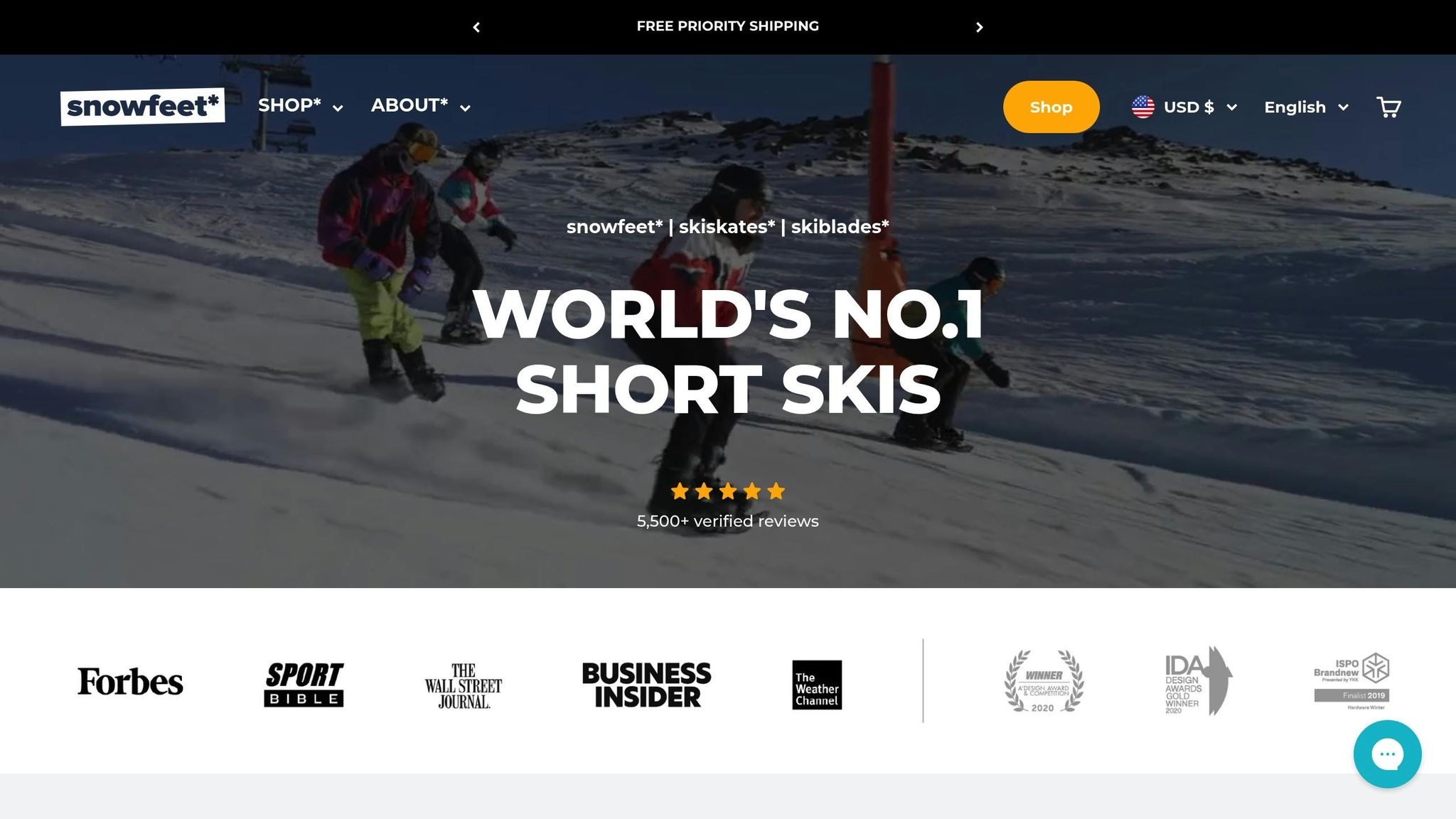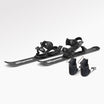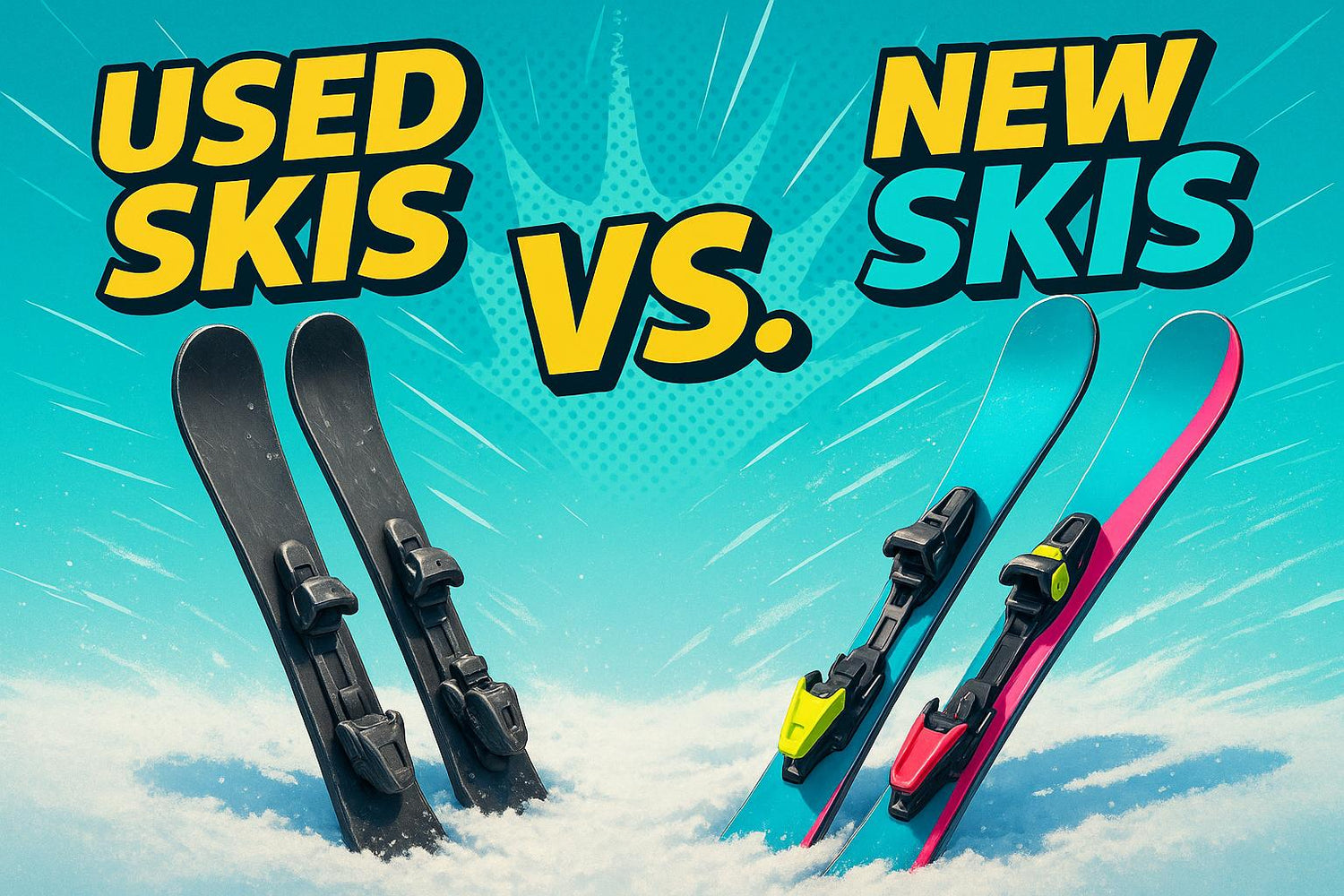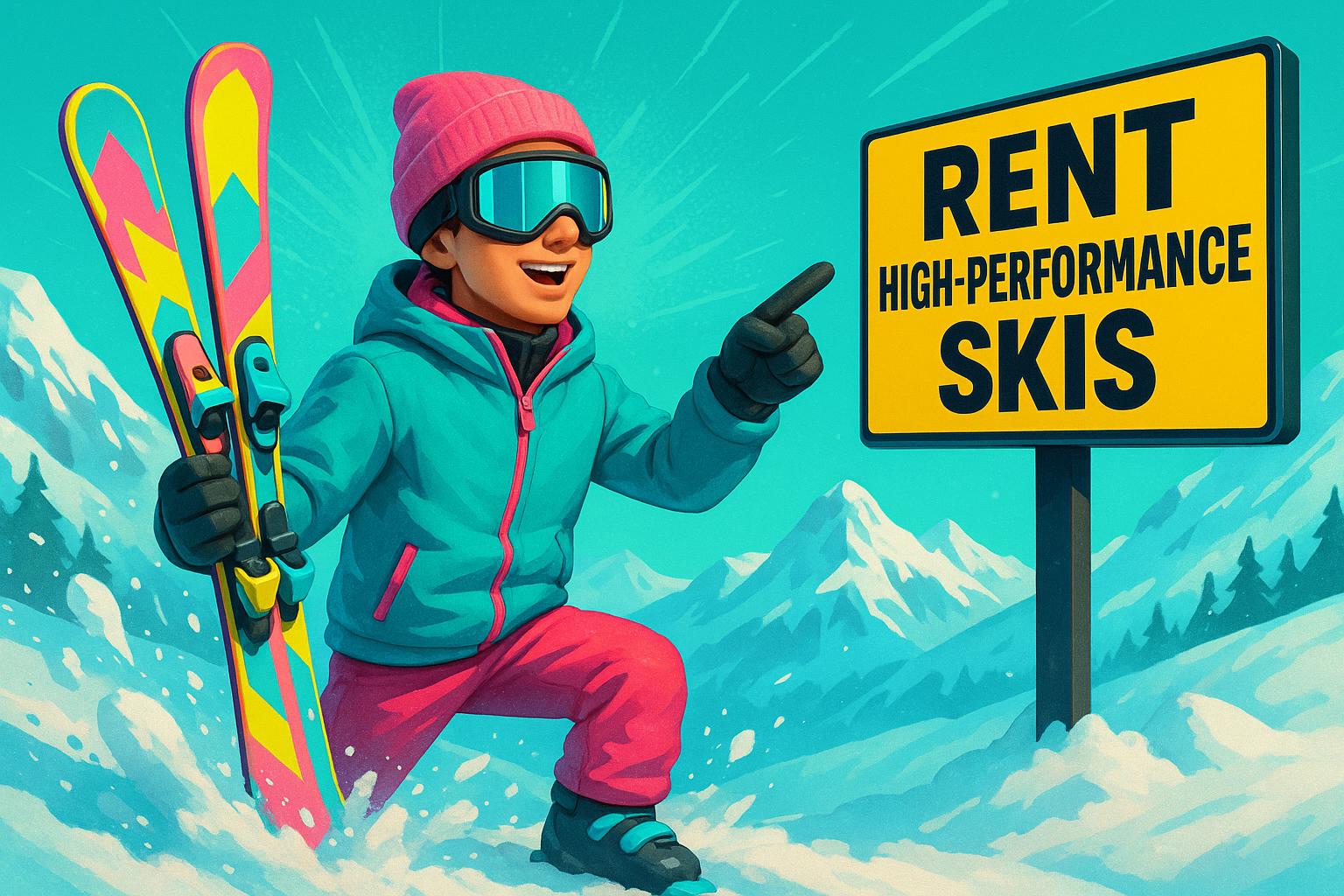Here’s the deal: buying skis boils down to budget, performance needs, and how often you hit the slopes. Used skis save you money upfront (around $200–$600) and are a solid pick for beginners or casual skiers. But they come with risks like hidden damage or outdated bindings. New skis, priced between $400–$1,200, offer cutting-edge designs, warranties, and pristine condition - but they’ll cost you more.
Want a third option? Compact gear like Snowfeet* is gaining traction. These mini skis, starting at $150, are easy to learn, work with regular winter boots, and fit in a backpack. Perfect for anyone tired of lugging around bulky equipment or paying for rentals.
Quick Comparison
| Factor | Used Skis | New Skis | Snowfeet* |
|---|---|---|---|
| Price | $200–$600 | $400–$1,200 | $150–$690 |
| Condition Risk | Possible issues | Brand-new | Brand-new |
| Boots Needed | Ski boots ($200+) | Ski boots ($200+) | Regular winter boots |
| Storage/Transport | Bulky | Bulky | Fits in a backpack |
| Learning Curve | Moderate | Moderate | Easy |
Bottom line: If you’re on a budget, go used but inspect carefully. For the latest features, new skis are worth it. Want simple, portable gear? Check out Snowfeet*. Let’s dive deeper into your options!
Pot of gold or a trap for the unwary!? - Buying second hand skis
Used Skis vs. New Skis: Complete Comparison
Choosing between used and new skis can feel like a big decision. Let’s break down the pros and cons of each option so you can pick what works best for your winter adventures.
Used Skis: Pros
If you're looking to save some cash, used skis are a great option. They often come with premium features at a fraction of the cost of new ones. Plus, buying used is a more eco-friendly choice since you're giving gear a second life instead of contributing to new production.
Used Skis: Cons
But there are some risks with used skis. Hidden issues like core damage, delamination, or worn edges can be hard to spot at first glance. The selection can also be hit or miss - finding the right size, style, or gender-specific design might take some digging. On top of that, older bindings may not meet current safety standards, and upgrading or remounting them can add to your expenses.
New Skis: Benefits and Drawbacks
Why New Skis Stand Out
New skis come packed with the latest materials and designs, giving you access to cutting-edge technology. They also include a manufacturer warranty, and you'll have your pick of sizes, flex levels, and styles to match your specific needs.
The Financial Reality
The downside? New skis come with a hefty price tag. Once you add in bindings, mounting, and specialized boots, the total cost can climb quickly. And keep in mind, new skis lose value fast after the first few uses, which might matter if you plan to upgrade often.
Side-by-Side Comparison: Used vs. New Skis
| Factor | Used Skis | New Skis |
|---|---|---|
| Initial Cost | Lower upfront cost | Higher upfront cost |
| Total Setup Cost | Generally more affordable | Premium expense with extras |
| Technology | May include older designs | Features the latest innovations |
| Warranty | Usually no coverage | Manufacturer warranty included |
| Selection | Limited availability | Wide range of options |
| Condition Risk | Potential hidden damage | Brand-new, pristine condition |
| Resale Value | Already depreciated | Depreciates quickly after use |
| Environmental Impact | Reuses existing equipment | Higher impact from new production |
A Modern Alternative: Snowfeet*

If neither used nor new skis quite fit your needs, there’s another option to consider - Snowfeet*. These compact Skiskates are shaking things up in the winter sports world. Unlike traditional skis, they don’t require expensive, specialized boots. You can pair them with your regular winter footwear, making them a budget-friendly and convenient alternative.
Snowfeet* products are also easy to store and transport, which is a huge plus if you’re short on space. With competitive pricing and versatile performance, they’re becoming a go-to choice for those who want simplicity without sacrificing fun on the slopes. Whether you're a seasoned skier or just looking for a fresh way to enjoy the snow, Snowfeet* might be the perfect fit.
How to Check Used Skis Before Buying
Making sure a pair of used skis is in good condition can save you money and help you avoid surprise repair costs.
Ski Inspection Checklist
Start with the Edges
Run your finger along the entire edge of the ski. It should feel smooth, with no gouges, cracks, bends, or heavy rust. Surface rust isn’t a big deal and can usually be cleaned up, but deeper rust could mean the skis were neglected. Also, check if there’s enough metal left - edges can get worn down from frequent tuning over the years.
Hold the ski at eye level and look straight down its edge. It should be straight, not twisted or wavy. Any warping could affect how the skis perform on the slopes.
Examine the Base
Take a close look at the base of the ski. Minor scratches and small gouges are normal and can be repaired, but deep cuts that expose the core are a red flag. You’ll also want to check for any spots where the base material is peeling or separating - this could mean delamination, which is expensive to fix.
Check the Top Sheet and Bindings
A few cosmetic scuffs or chips on the top sheet are fine, but cracks or deep chips that go through the top layer might weaken the ski.
Bindings are a safety-critical component. Check their manufacture date - bindings older than 10–15 years may not meet current safety standards, and many service centers won’t service them. Even if they look fine, outdated bindings might need replacing, which can get pricey.
Test the Flex and Camber
Place the ski flat on the ground and press down on its center. It should flex smoothly and bounce back to its original shape. If it doesn’t, the ski might have core damage.
From the side, check the camber - the slight upward curve in the middle of the ski. The camber should look even and symmetrical. Flat spots or uneven curves could mean structural problems.
When to Choose Used Skis
Used skis can be a great option for beginners or casual skiers who want to save money. They let you hit the slopes without the big upfront cost of new gear - just make sure they pass a thorough inspection.
If you’re an aggressive skier or need specific performance features, though, new skis might be worth the extra investment. They come with a warranty and the assurance that everything is in perfect shape.
Think about how often you’ll ski and what kind of performance you need to decide if used skis are the right call for you.
Why New Skis Are Worth It in 2025
Sure, used skis might save you some cash upfront, but new skis bring a whole lot more to the table. With the ski industry moving at lightning speed, the 2025 models are packed with features that weren’t even on the radar a few years back.
Latest Technology and Design Features
By 2025, even skis that are just five years old feel like relics. New models come loaded with advancements that can take your performance to the next level - right out of the box.
Manufacturers are using cutting-edge materials and construction techniques to make skis lighter, stronger, and more responsive. These updates don’t just improve performance - they also boost durability and safety. The improved flex patterns in the 2025 models adapt better to changing snow conditions, giving you a smoother, more controlled ride.
And let’s not forget the reliability factor. Used skis can have hidden wear and tear that might not show up until you're on the mountain. With new skis, you get consistent, dependable performance from day one. Whether you’re just starting out or chasing expert-level runs, that consistency matters.
The design upgrades in the latest models also aim to make skiing more user-friendly and enjoyable for all skill levels. Whether you're a beginner learning the ropes or a seasoned pro chasing specific performance traits, these skis are built to match your needs. Plus, they bring a level of comfort and protection that older skis just can’t compete with.
Warranty Protection and Consumer Rights
Here’s another reason to go for new skis: the warranty. Most new skis come with a two-year warranty when purchased from authorized retailers. This means you’re covered for any manufacturing or material defects.
Big brands like Armada and Dynafit stand behind their products, offering to repair or replace defective skis at no cost to you. That kind of support is a game-changer. It’s a layer of security that used skis simply can’t provide.
When you think about potential repair or replacement costs, the warranty alone makes new skis a smart investment. Add that to the performance and durability benefits, and it’s clear why new skis are worth every penny in today’s fast-moving winter sports world.
sbb-itb-17ade95
Why Snowfeet* Beats Both Options
When it comes to winter sports gear, traditional skis - whether new or used - come with their share of challenges. They’re heavy, awkward to carry, and built for length rather than convenience. Snowfeet* flips the script by focusing on portability, ease of use, and an approachable learning curve, making them a standout choice for anyone looking to enjoy the snow.
What Makes Snowfeet* Different
Snowfeet* changes the game with its compact, lightweight design. At just 15 inches long, Snowfeet* Mini Ski Skates are a fraction of the size of traditional skis, which typically range from 5 to 6 feet. This makes them easy to toss in a backpack and take anywhere - no roof racks or bulky ski bags required.
Another major advantage? They’re much easier to learn. Traditional skiing often requires weeks (or even months) to master techniques like parallel turns and edge control. Snowfeet*, on the other hand, are designed to help beginners gain confidence and start carving turns in just a day or two. It’s an instant way to make winter sports more fun and approachable.
And let’s talk about boots. Ski resorts often charge $40–$50 a day for rental boots, which aren’t always the most comfortable. Snowfeet* works with your regular winter boots, saving you money and sparing you the hassle of renting specialized gear.
Weight is another win for Snowfeet*. Traditional ski setups are heavy - not just the skis themselves, but also the clunky boots that go with them. Snowfeet* keeps things light, making them easier to carry and less tiring to use.
Here’s a quick comparison to break it all down:
Snowfeet* vs. Regular Skis Comparison
| Feature | Traditional Skis | Snowfeet* Products |
|---|---|---|
| Length | 5–6 feet | 15–47 inches |
| Weight | Heavier | Lightweight and portable |
| Transport | Needs roof racks/ski bags | Fits in a standard backpack |
| Boot Cost | $40–$50/day rental | Works with your own boots |
| Learning Time | Weeks to months | Hours to days |
| Price Range | $300–$1,200+ | $150–$690 |
| Storage | Requires ample space | Fits on a shelf |
Ideal for Everyone
Snowfeet* isn’t just about better gear - it’s about making winter sports more accessible and fun for everyone. For families, Snowfeet* offers an easy way to hit the slopes together without the hassle of expensive lessons or intimidating equipment. Kids and parents alike can start enjoying the snow right away.
Experienced skiers, on the other hand, will love the agility and versatility Snowfeet* provides. Whether it’s quick turns, fast direction changes, or casual runs on backyard hills, Snowfeet* adds a fresh twist to the winter sports experience.
In short, Snowfeet* combines modern design with ease of use, creating an ultralight, user-friendly alternative to traditional skis. Whether you’re a seasoned skier or just starting out, they’re a smart, fun choice for today’s snow enthusiasts.
How to Choose What's Right for You
Picking the right gear - whether it’s used skis, new skis, or Snowfeet* - is all about figuring out what fits your needs and priorities. Sure, price matters, but it’s also about what works for your lifestyle, skill level, and winter adventures.
Key Factors to Consider
Budget:
Used skis usually cost between $100 and $400, but don’t forget to factor in potential repairs and binding adjustments. New skis range from $300 to over $1,200, while Snowfeet* products are priced in the $150 to $690 range.
Skill Level:
Learning traditional skiing takes weeks, which can be tough for beginners or families just looking for some fun on the slopes. Snowfeet* products, on the other hand, are beginner-friendly - you can start carving turns and having fun within hours.
Storage and Transportation:
Traditional skis are bulky and a hassle to move around. Snowfeet* products are compact and portable, making them easy to store and transport. They’ll fit in a backpack or on a shelf, no problem.
Frequency and Terrain:
If you don’t ski often or if you like to mix up your terrain, spending $800 or more on traditional skis might not make sense. Snowfeet* products are low-maintenance and versatile, making them a solid choice for occasional users exploring different settings.
With these factors in mind, Snowfeet* often stands out as the better option for most people.
Why Snowfeet* Might Be Your Best Choice
For many skiers - especially beginners and families - Snowfeet* products come with some clear perks:
Quick Learning Curve:
Traditional skis can take a lot of time (and patience) to master. With Snowfeet*, you’re up and running in just a few hours. That means less time struggling and more time enjoying your day on the slopes.
Cost Savings Over Time:
A $199 Snowfeet* PRO can save you money on boot rentals, which typically cost $40–$50 a day. After just a few outings, the savings can cover your initial investment. That’s a win for your wallet.
Versatility:
Traditional skis are mostly built for resort skiing. Snowfeet* products? They work well across different conditions, so you can use them wherever your winter adventures take you.
Convenience:
Snowfeet* gear is small enough to toss in a backpack and simple to store or transport. Whether it’s a quick local outing or a winter getaway, they’re way easier to manage than traditional ski equipment.
A Modern Approach to Winter Sports:
As winter sports evolve to focus on accessibility and portability, long, traditional skis can feel limiting. Snowfeet* offers a fresh, fun take - perfect for beginners, families, and anyone looking for a hassle-free way to enjoy the snow.
Of course, if you’re a serious racer, a powder chaser, or someone chasing that classic alpine experience, traditional skis might still be your go-to. But for most people - whether you’re new to skiing, part of a family looking for fun, or just want versatile gear - Snowfeet* delivers more value, more fun, and way fewer headaches.
Conclusion: Winter Sports Are Changing
When it comes to choosing between used and new skis, it often boils down to a simple trade-off: saving money versus getting the latest features and warranty protection. Used skis are easier on the wallet but come with the risk of hidden flaws. New skis, on the other hand, offer the latest technology and peace of mind - at a higher price. But now, there’s a fresh twist shaking up this traditional debate.
The real shift in winter sports isn’t just about picking between old and new skis. It’s about embracing shorter, more versatile gear that’s changing the way people hit the slopes. Take Snowfeet* for example - they offer an affordable, fun alternative without the usual downsides of traditional skis.
While brands like Rossignol, K2, and Salomon continue to focus on longer, specialized skis that demand more time and skill to master, Snowfeet* offers a whole new approach. They’re compact, easy to learn, and fit right into a backpack. No need to mess with bulky boots or bindings. For many, it’s a game-changer - gear that’s simple to use and ready to go whenever you are.
Winter sports are evolving to become more welcoming and easier to enjoy. Whether you’re a family looking for a fun weekend activity, a beginner hoping to skip expensive lessons, or someone who values gear that’s lightweight and portable, the old "longer is better" mindset is being challenged. The future of winter sports is all about making it easier for everyone to join in, and Snowfeet* is leading the charge.
The days of experts insisting on long skis are fading. Today’s winter enthusiasts want gear that’s convenient and efficient. That’s why innovative options like Snowfeet* are carving out their place as the perfect modern alternative to traditional skis.
FAQs
How can I tell if used skis are in good condition before buying?
When you're checking out used skis, start with the edges. Look for any bends, cracks, rust, or dull spots. Ideally, the edges should feel sharp and smooth, without any major damage. Next, move on to the base - keep an eye out for deep scratches, gouges, or any signs of delamination, especially near the tips and tails. These could signal deeper structural issues.
Don’t forget to examine the bindings closely. Make sure they’re securely attached and working as they should. Check for loose screws or parts that look worn out. Lastly, give the entire ski a once-over for cracks, separation, or other wear and tear that might mess with performance. These simple checks can help you snag a pair of skis that are safe and slope-ready!
What makes Snowfeet* easier to learn and more enjoyable compared to traditional skis?
Snowfeet* make learning winter sports easier and more fun compared to traditional skis. Their shorter, lightweight design helps you control your movements better, make quick turns, and gain confidence - perfect for beginners and intermediate users.
Because of their compact size, Snowfeet* are less intimidating than full-sized skis or snowboards. They offer quick feedback and improved maneuverability, making them a great choice whether you're just starting out or want a versatile option for your snow adventures.
Are new skis a good investment for casual skiers who only go a few times a year?
If you’re someone who hits the slopes just a handful of times each season, buying a brand-new pair of skis might not make the most sense. Skis are built to perform well for about 60 to 100 days of use, so if you’re not skiing regularly, you might not get your money’s worth. Instead, renting or even picking up a used pair could be a smarter, more budget-friendly option for occasional skiers.
That said, there’s another fun option to consider: Snowfeet* products like Skiblades and mini skis. These compact alternatives to traditional skis are a great match for beginners and casual skiers. Why? Because they’re lightweight, easy to carry, and don’t break the bank. Plus, they’re all about having a blast on the slopes without the hassle of bulky gear or the commitment to pricey equipment. If you’re looking for something portable and simple that still delivers plenty of fun, Snowfeet* might be just what you need.


































Leave a comment
This site is protected by hCaptcha and the hCaptcha Privacy Policy and Terms of Service apply.